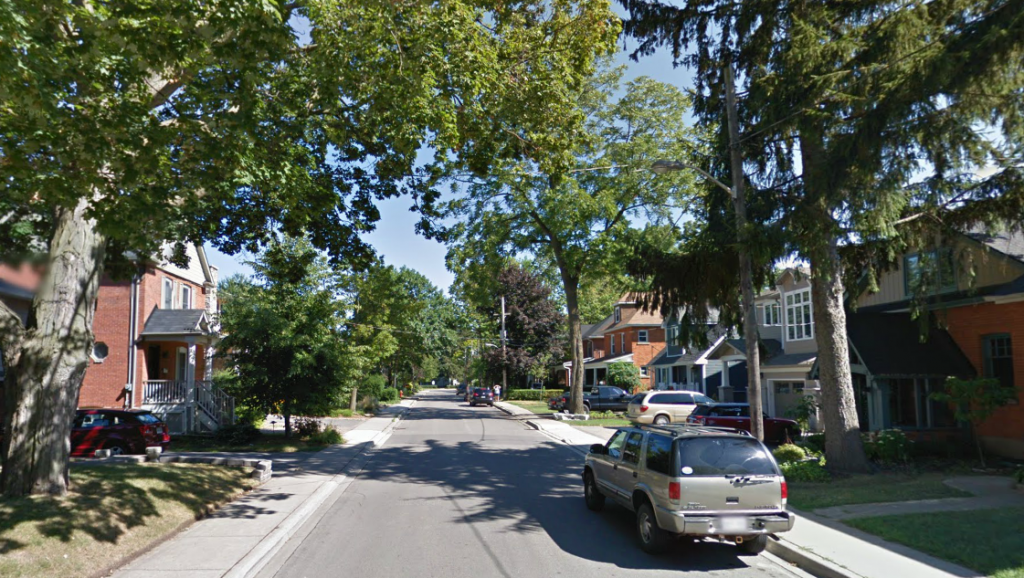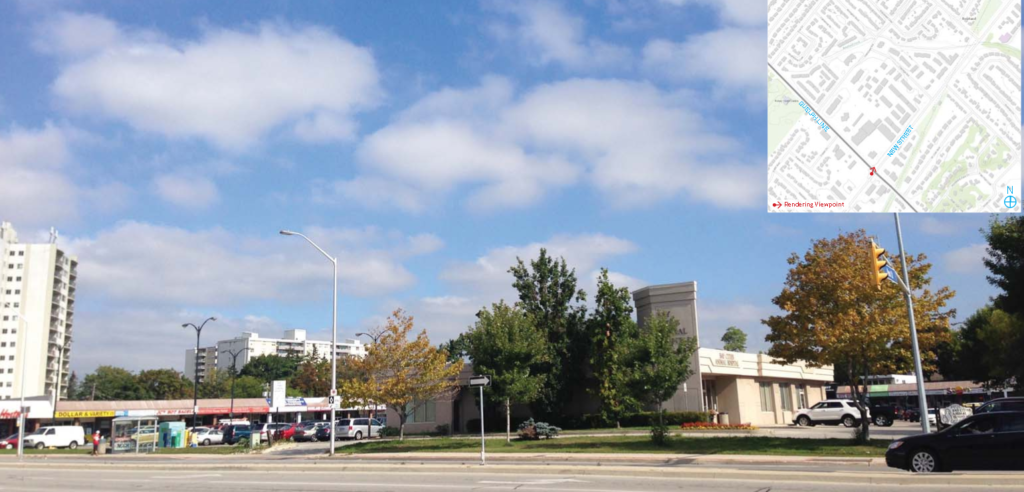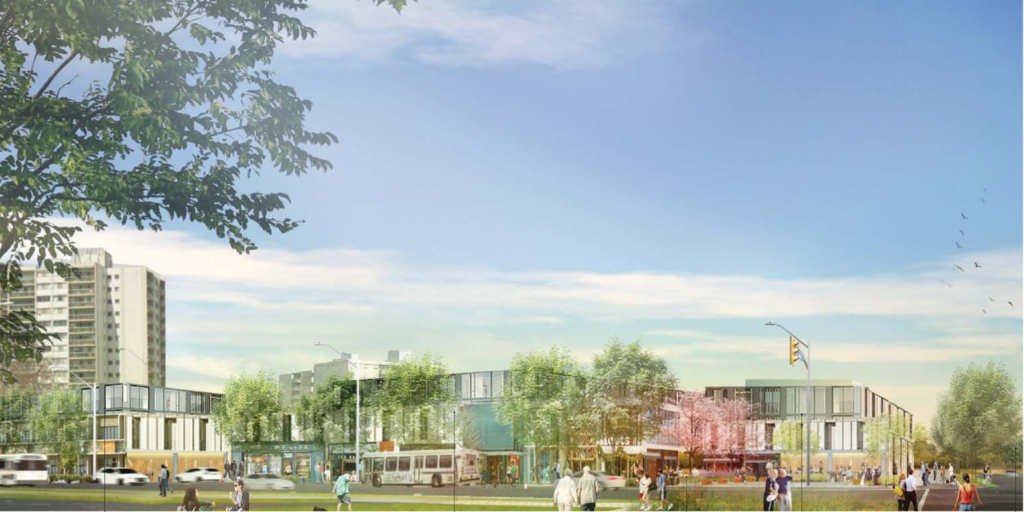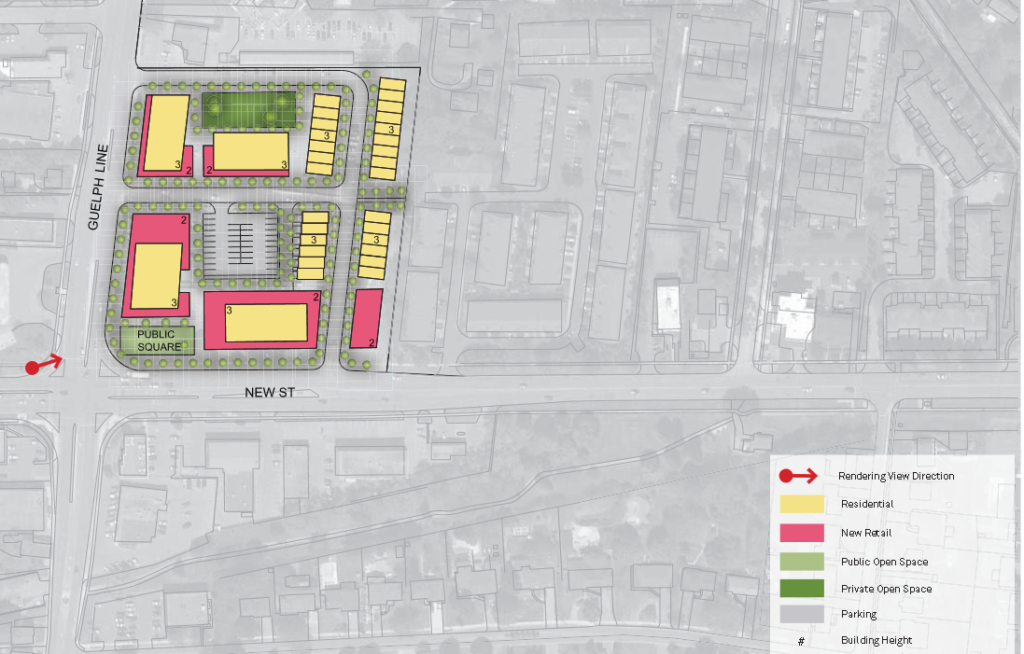 By Carol Gottlob
By Carol Gottlob
July 7, 2016
BURLINGTON, ON
I live in the east end of Burlington, around New Street, and I always marvel when I see photographs taken when my part of town was being developed. The few trees that could be seen were very small
Today when I drive my bike down the street or take my dog for a walk I see trees that are mature and give my neighbourhood a character of their own which is indeed worth preserving.

Caroline looking East from Hager: community wants to retain the single family home zoning for the precinct. The trees are for the most part on private property.
When you look at those houses “west of Brant” which were likely built in the 1930’s and ’40’s, some in the 50’s, do you think those majestic trees were there then? The shrubbery and landscaping are features that we have added.
Over the years they have filled in the neighbourhood to give it that stately effect. Likewise, I believe intensification along main thoroughfares and increased public transit meets the needs of the ever-growing “single society”.
We live in a society where there is an increasing number of divorced, widowed and selectively single people, modest, affordable living space with plenty of opportunity for social interaction meets their needs
(Don’t, however, get me started on the notion of “affordable”. That is an entirely different, but very critical, debate).
I believe, when these new higher density developments are built, over time, people will fill in the spaces between them with not just green, but many colours, where people can rest and breathe.
The only thing I don’t understand is why we are going from urban sprawl to high-rise in one fell swoop. Is there nothing in between?
I believe that one of the reason we like travelling to Europe so much is because the cities there are high density, not high-rise.
High density gives us no choice but to greet the people we meet and interact with them, but high-rise gives us a good excuse to park in the underground and let ourselves get sucked up to the 20-somethingest floor, without even making eye contact with another soul.
I think we can do better than that.
What might that better look like?

The plaza at New Street and Guelph Line – as it looks today. The planners think there is much more potential for the site and suggest some possibilities.

Possible intensification for the plaza at New and Guelph Line – all this could be done within the existing zoning and Official Plan.

The planners suggest what could be built on the plaza at Guelph Line and New street.
We are absolutely blessed to have a Great Lake at our doorstep, an escarpment in our back yard and a protected Greenbelt arching through our region. Within minutes, we can enjoy a long, sandy beach, kilometres of trail in acres of forest, breath-taking views over the lake, and quaint villages to visit tucked in amongst farmland where you can pick fresh fruit or buy local honey.
Whether you prefer to travel by car, bike or on foot, there is so much within easy access, and a lot of it accessible by public transit as well. Where else can you find this?!
The Burlington I foresee, builds upon what it has already built. It doesn’t mean destroying existing neighbourhoods, nor the trees that make them so special. Leave the lovely homes for families to raise their children, so they can ride their bikes, play street hockey or where folks can walk their dogs through leafy neighbourhoods. On the perimeters of those neighbourhoods, where main arteries intersect and small businesses tend to locate, add mid to high density housing and create a commercial/transit/residential hub to accommodate the seniors and the singles who do not rely on automobile transportation.
The intersection of Guelph Line and New Street is a good example. There are businesses, behind them there are apartment buildings, behind them some town homes and then tucked behind them, detached homes. Such variety of accommodation offers many more options for people, depending on what stage of life they are going through
The Roseland Plaza, and several others like it, would do well to re-invent themselves, with fewer parking spaces and more frequent smaller buses bringing seniors right up to the pharmacy to get their prescriptions, to the barber shop for a haircut or the coffee shop to meet their pals, rather than trying to make their way in from the street across a dangerous (and in winter, slippery) parking lot. Good public transit plays a big part in convincing people to leave the car at home.
It is unsettling to see existing homes/buildings torn down, such as we are witnessing at the New St Maranatha development. Holes in the ground, gaping spaces, and altered vistas can be unfamiliar and disorienting. Yet in time, as people move into these new sites, trees grow in, gardens are planted and familiar faces come and go, the starkness of it all softens and the architecture and nature blend to form a very liveable landscape for our seniors, our children and our pets.
 Carol Gottlob has been a candidate for public office (ward 4) and is a member of the Burlington Green board. She teaches English as a second Language to new Canadians.
Carol Gottlob has been a candidate for public office (ward 4) and is a member of the Burlington Green board. She teaches English as a second Language to new Canadians.


















Urban sprawl to high-rise in one fell swoop? Hardly. I can think of only a handful of high-rises that have been built in Burlington in the last decade.
All the wonderful ideas for neighbourhoods described in this article are already happening:
“Leave the lovely homes for families to raise their children, so they can ride their bikes, play street hockey or where folks can walk their dogs through leafy neighbourhoods. On the perimeters of those neighbourhoods, where main arteries intersect and small businesses tend to locate, add mid to high density housing and create a commercial/transit/residential hub to accommodate the seniors and the singles who do not rely on automobile transportation.” You’ve just described Burlington’s Official Plan. This is already the city’s intensification plan. Burlington is not going to raze its lovely homes with leafy neighbourhoods any time soon.
“The only thing I don’t understand is why we are going from urban sprawl to high-rise in one fell swoop. Is there nothing in between?” Yes, there’s lots in between and it’s already happening. New townhouse complexes throughout the city that have been gradually adding density (Old Plains Rd, Ghent, Queensway) are a great example. All the new live/work units on Plains Rd, Fairview and in downtown Burlington are great examples. The new Saxony building going up at Locust and Elgin is a great example.
“Holes in the ground, gaping spaces, and altered vistas can be unfamiliar and disorienting. In time, as people move into these new sites, trees grow in, gardens are planted and familiar faces come and go, the starkness of it all softens and the architecture and nature blend to form a very liveable landscape.” Right. So….I don’t understand the problem here.
I agree with Greg; easy customer access is essential for businesses to succeed. Adequate parking for peak business periods is an unavoidable basic requirement, even though it may result in slack capacity at other times.
The author is right that a good reliable transit system will make all the difference. Sadly, I can’t see that happening here in Burlington. There’s simply no common sense being shown by those who plan our transit.
Too many people complain that the buses are noisy and unwieldy on their streets, and those in charge actually cancel routes.
Transit management erect benches but not more shelters, so transit users are exposed to rough weather.
The bus routes are inconvenient and unreliable, so those in charge shrug and say that people don’t want to take buses anymore.
It’s my strong belief that anyone who is involved in transit planning and management should be forced to use the system every day of their lives.
Yes, a good transit system would change our city for the better, but don’t hold your breath.
I totally agree with the article and Hans. The powers that be are only interested in money – not the communities. On the surface it looks like the investors rule – not the city.
Carol you make a lot of good points. There is a trend of loss of green space with new development and re-development in Burlington. I see it not as just the issue of mandated intensification. It is the attempted “over-intensification” by developers in areas to be intensified. These areas are already zoned for appropriate intensification using mid-rise (and sometimes high-rise) buildings. But developers know that higher buildings mean higher profits, so they push the envelope nearly every time. And the OMB is not constrained by our Official Plan, so it often becomes somewhat of an accomplice in pushing this envelope.
Re: ..”why we are going from urban sprawl to high-rise in one fell swoop..?” – simply because it’s profitable. And because opposition is ineffective as long as the OMB wields excessive power to overrule legitimate municipal plans.
Fyi. I can eyeball that the parking is probably not enough for the red retail sections. It’s hard to tell as they could all be useless micro-units. Doesn’t look to me like it replaces what is at that location now.
Developers hate real high volume retail because it requires parking as 98% of your customers are coming in by car for the next 10 year at least. This requires parking and parking is space you can’t put a building on easily. Plus businesses least space in long term chunks. People buy units from you and after it’s developed you can walk away and leave all problems behind you.
You can intensify that plaza, but any plan that reduces the quality of the retail and that amount of parking is not of benefit to the community. All of those businesses will just disappear replaces by tax offices, salons and nail places.
You will be driving and bussing long distances for everything else you need after that.
Businesses all over North America tend to grossly over-estimate the percentage of their patrons that come by car, and I suspect that you have done the same here. For the most part, minimum parking requirements are far in excess of what the typical business needs to provide even on their busiest days. As the population ages, the need for businesses to provide storage for large numbers of vehicles will decrease.
Minimum parking requirements add tremendous costs, and make it next to impossible for local business owners to compete with national chains and big boxes on the outside of the city where land is far cheaper. In addition to that, big parking lots reduce the value of nearby properties, create heat islands and increased runoff that offload costs onto taxpayers, and reduce the walkability and bikeability of the local neighbourhood. Ultimately parking supply is a tough thing to get right.
This is why so many modern cities are eliminating minimum parking requirements and letting businesses and developers determine how much parking they need to serve their customers, while designing the development in such a way that it is welcoming not only to those coming by car, but to the neighbourhood at large. The quality of the built form is critical.
The drawback is that all comes with a cost. If a developer has to dig several stories down to build a big parking garage and deal with the added complexities that brings with respect to utilities, etc, more units are needed to offset that cost. More units in the same space means more height. If it’s not economic to build, nothing will be built. Which means if we aren’t willing to give a little in terms of height, the community will just end up being stuck with a big parking lot that sucks value out, instead of a development that adds value.
Just go to Clapsons corners – you can see how harmful parking is for businesses. People who own these businesses know how important customer access is. I can’t help how people work – I’m just describing how businesses that intend to make money work. No business that has any ideas what they are doing will risk cutting itself off from potential customers.
Greg: take another look at Clappison’s Corners. Is there a single business there that is not a major chain owned by a national or foreign-owned conglomerate?
I can’t understand why you would prefer that model of development over more compact mixed-use forms. By funding it, we not only deplete our ability to sustain all the infrastructure needed for this kind of retail to survive, we help to kill off our local enterprises in the process. These are the people who contribute to our charities, volunteer with our kids. As a community we need to prioritize our local businesses.
At the same time you criticise mixed-use forms as not preserving enough green space. Just how much green space is there at Clappison’s? And what value does the landscaped berm between the Wal-Mart and the Kelsey’s add to a community?
As for “cutting themselves off from customers” that is not what I’m talking about. I’m simply saying we shouldn’t force businesses to provide more parking than they need. That is an unfair subsidy to the big chains in huge cookie-cutter plazas at the edge of town. The big box model is the only one that works in that environment. Even they are very fragile as Target can attest to.
Every business works to minimize costs, and land is one of the largest. Furthermore, businesses also cut themselves off from customers when they build in a manner which deters people from coming on foot or via transit.
I suggest some further reading on the topic of what this kind of development does to a community, and its impact on the financial well-being over time. https://www.strongtowns.org/the-growth-ponzi-scheme
We are NOT going from suburban sprawl to “high rise” in one “fell swoop” – Burlington has been moving away from suburban sprawl for over twenty years now. And, it is NOT about moving to high rise – Yes there will be and is high rise in some areas, but it is moving to increased density that makes a livable urban city and one that will be more affordable to the taxpayer, and increased d`density should have green space and trees while preserving existing neighbourhoods.
Yes that is what the city says – but it’s all just a facade to facilitate – increased density every possible place.
Just review these staff recommendations.
https://www.burlington.ca/en/services-for-you/resources/Initiative%20Projects/Official_Plan_Review/Staff_Reports/PB-29-16-FOR-WEB-Urban-Structure-Intensification.pdf
Not one single word about preserving “green space” just endless changes that allow a massive building to go up beside your house on the school park where you kids used to play – with zero input from local residents.
Yes, You could use density to create a vibrant green city. No one is doing that at the moment.
The document you linked to outlines the areas for intensification:
“The Primary Intensification Area will be comprised of major nodes and corridors,
which may include various residential, mixed use, commercial or employment
land uses in areas which have the greatest potential to accommodate
intensification including: the city’s Urban Growth Centre (UGC); mixed use areas
of the Uptown Urban Centre; the Aldershot, Burlington and Appleby Mobility
Hubs; the Plains Road/Fairview Street Urban Corridor; the Brant Street Urban
Corridor and aging Neighbourhood Centres located south of the QEW. ”
That’s it. No need to fear-monger about “increased density in every possible place” and massive buildings going up beside people’s houses. Unless someone lives next door to one of the major corridors listed that is not what the City has planned.